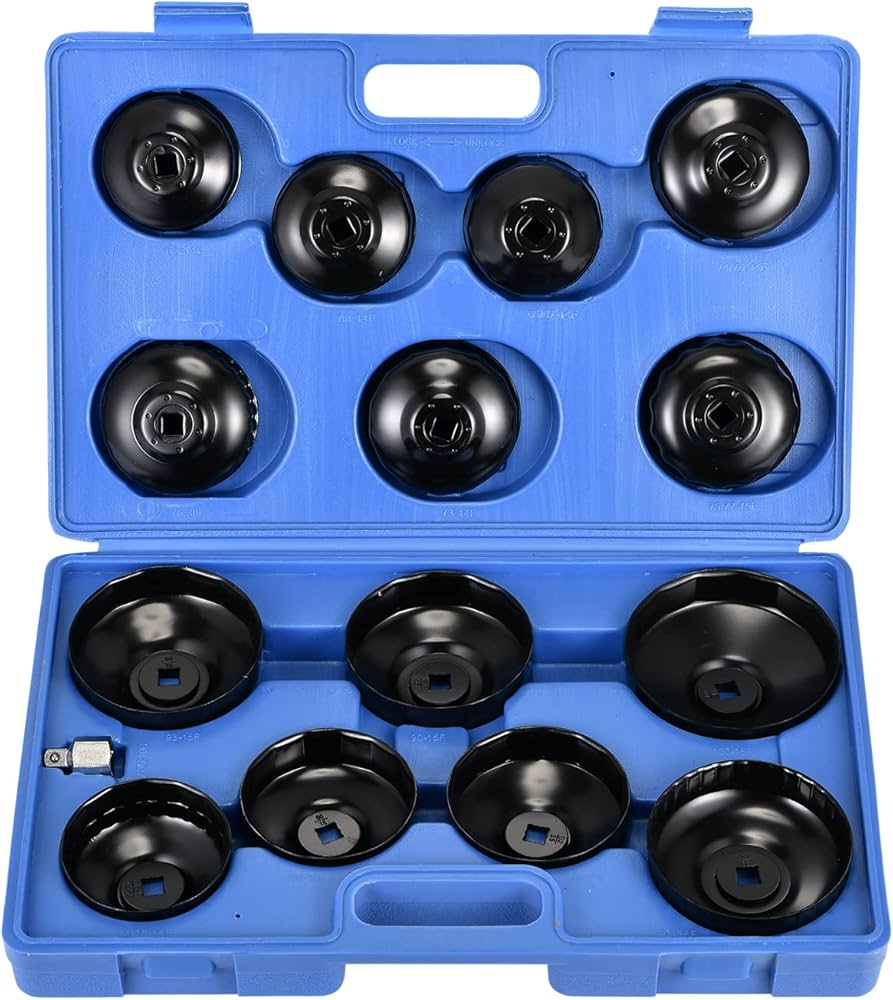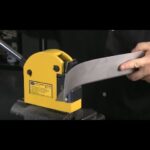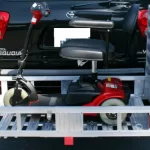An oil filter socket is a specialized tool designed to aid in the removal and installation of oil filters on vehicles. Its primary purpose is to provide a secure grip on the oil filter housing, allowing for easy loosening and tightening during oil change procedures.
Oil filter sockets come in various types and sizes to accommodate different vehicle makes and models. The most common types include:
- Cup-Style Oil Filter Sockets: These sockets feature a cup-shaped design that fits snugly over the oil filter housing. They typically have a rubber or plastic lining to prevent damage to the filter and provide a secure grip.
- Strap-Style Oil Filter Sockets: These sockets consist of a metal band or strap that wraps around the oil filter housing. They often have a ratcheting mechanism or a quick-release feature for easy adjustment and removal.
- Swivel Oil Filter Sockets: These sockets incorporate a swivel joint that allows for better maneuverability and access to hard-to-reach oil filters. The swivel joint helps to prevent over-tightening or cross-threading.
- Universal Oil Filter Sockets: As the name suggests, universal oil filter sockets are designed to fit a wide range of oil filter sizes and shapes. They typically feature adjustable jaws or a flexible design to accommodate different filter diameters.
Oil filter sockets are available in various sizes, ranging from small sockets suitable for compact cars to larger sizes for trucks and heavy-duty vehicles. They are typically made from durable materials like chrome-vanadium steel or impact-resistant plastics to withstand the demands of automotive repair tasks.
Table of Contents
Benefits and Advantages of Oil Filter Sockets
Oil filter sockets are specialized tools designed to make the task of removing and installing oil filters more efficient and safer. These sockets offer several advantages over traditional wrenches or pliers:
Proper Grip and Fit: Oil filter sockets are engineered to fit snugly around the oil filter’s housing, providing a secure grip that prevents slippage or rounding of the filter during removal or installation. This ensures a smooth and controlled process, reducing the risk of damaging the filter or the surrounding components.
Leverage and Torque Control: The design of oil filter sockets, with their long handle and knurled grip, allows for better leverage and torque control. This makes it easier to break loose stubborn filters without excessive force, minimizing the risk of over-tightening or stripping the filter during installation.
Protection Against Spills: Many oil filter sockets feature a built-in channel or cup design that catches any residual oil that may drip from the filter during removal. This helps prevent messy spills and ensures a cleaner work area.
Time and Effort Savings: By providing a secure grip and proper fit, oil filter sockets streamline the oil change process, saving time and reducing the physical effort required compared to using ill-suited tools that may slip or require excessive force.
Safety Considerations: Using the right tool for the job is crucial for safety. Oil filter sockets are designed to handle the specific task of oil filter removal and installation, reducing the risk of injuries caused by tools slipping or breaking. Additionally, their ergonomic design helps prevent hand strain or fatigue during the process.
Oil Filter Socket Types and Materials
Oil filter sockets come in various designs to accommodate different types of oil filters and vehicle configurations. The most common types are cup-style, strap-style, and chain-style sockets.
Cup-style Sockets: These sockets feature a cylindrical cup shape that fits snugly over the oil filter. They typically have a knurled or ridged outer surface for better grip and leverage when loosening or tightening the filter. Cup-style sockets are often made of durable materials like steel or aluminum alloys to withstand the torque required for oil filter removal and installation.
Strap-style Sockets: Instead of a cup shape, strap-style sockets have a flexible metal strap that wraps around the oil filter. This design allows for a secure grip on filters of various sizes and shapes. The strap is usually made of sturdy steel or aluminum and may have a quick-release mechanism for easy removal and adjustment.
Chain-style Sockets: These sockets consist of a chain or series of interconnected links that can be looped around the oil filter. The chain conforms to the filter’s shape, providing a secure grip. Chain-style sockets are particularly useful for accessing hard-to-reach filters or those with limited clearance around them. They are typically made of durable steel or other strong metal alloys.
Universal Sockets: Some oil filter sockets are designed to be universal, meaning they can accommodate a wide range of filter sizes and shapes. These sockets often feature adjustable components or multiple attachment options, such as a combination of cup, strap, and chain designs. Universal sockets offer versatility and can be a convenient choice for working on different vehicles or filter types.
Materials: Oil filter sockets are commonly made from durable materials like steel, aluminum alloys, or other strong metals. Steel sockets are known for their strength and resistance to deformation, making them suitable for heavy-duty applications. Aluminum sockets, while lighter, are also corrosion-resistant and provide sufficient strength for most oil filter removal and installation tasks.
Factors to Consider for Oil Filter Socket Compatibility
When selecting an oil filter socket, it’s crucial to consider several factors to ensure compatibility with your vehicle and make the job easier and more efficient. Here are some key considerations:
Filter Size: Oil filters come in various sizes, and you need a socket that fits the filter snugly. Measure the diameter of your vehicle’s oil filter or consult your owner’s manual to determine the correct size. Sockets are typically available in standard and metric sizes, so ensure you choose the right one.
Clearance: Depending on your vehicle’s engine bay layout, you may need a socket with an extended or offset design to reach the filter in tight spaces. Clearance around the filter can be limited by components like the engine block, transmission, or other accessories, so consider the socket’s shape and length for easy access.
Socket Material: Oil filter sockets are typically made from different materials, each with its own advantages:
- Steel: Durable and affordable, steel sockets are suitable for most applications but can be prone to rust over time.
- Chrome-Vanadium: This alloy offers increased strength and resistance to wear, making it a popular choice for professional mechanics.
- Impact-Grade: Designed for use with impact wrenches, these sockets are reinforced to withstand high torque and reduce the risk of rounding or deformation.
Consider the material based on your intended use and whether you’ll be using hand tools or power tools like impact wrenches.
By considering the filter size, clearance requirements, and socket material, you can select an oil filter socket that not only fits your vehicle but also makes the job more convenient and efficient. Proper tool selection can save you time, effort, and potential frustration during routine maintenance tasks.
How to Use Oil Filter Sockets
Step-by-Step Instructions
- Locate the Oil Filter: Before using an oil filter socket, locate the oil filter on your vehicle. It’s typically situated near the bottom of the engine block and can be accessed from the top or side, depending on your vehicle’s design.
- Choose the Correct Socket Size: Oil filter sockets come in various sizes to fit different filter diameters. Consult your vehicle’s owner’s manual or measure the filter’s diameter to determine the appropriate socket size.
- Attach the Socket to a Wrench or Ratchet: Oil filter sockets are designed to be used with a wrench or ratchet. Attach the socket securely to the tool, ensuring a tight fit.
- Position the Socket: Place the oil filter socket over the oil filter, ensuring it fits snugly around the filter’s base or casing.
- Apply Counterclockwise Rotation: With the socket securely positioned, apply counterclockwise rotation to the wrench or ratchet. This will loosen the filter, allowing you to unscrew it by hand once it’s loose enough.
- Unscrew the Filter: Once the filter is loosened, you should be able to unscrew it by hand. Rotate it counterclockwise until it’s completely detached from the engine block.
- Install the New Filter: After removing the old filter, install the new one by screwing it on clockwise until it’s hand-tight. Consult your vehicle’s manual for specific torque specifications.
Tips and Tricks
- Apply a light coating of fresh oil to the gasket of the new filter before installation to ensure a proper seal.
- Use oil filter sockets with a swivel joint for better maneuverability in tight spaces.
- Consider using a filter wrench or strap wrench if the filter is difficult to remove or if the socket doesn’t fit properly.
Common Mistakes to Avoid
- Don’t overtighten the new filter, as this can damage the gasket or the filter housing.
- Avoid using excessive force when loosening a stuck filter, as this can damage the housing or other engine components.
- Don’t forget to properly dispose of the old oil filter according to local regulations.
By following these steps, tips, and precautions, you can safely and effectively use oil filter sockets to change your vehicle’s oil filter during routine maintenance.
Proper Storage of Oil Filter Sockets
Proper storage of oil filter sockets is crucial to ensure their longevity and prevent rust and damage. Here are some tips for storing your oil filter sockets:
Keep Them Dry
Moisture is the primary enemy of metal tools like oil filter sockets. Always ensure that your sockets are completely dry before storing them. If they were exposed to moisture or used with wet hands, wipe them down thoroughly with a clean, dry cloth or let them air dry completely.
Use a Protective Coating
To further protect against rust and corrosion, consider applying a thin layer of protective coating or lubricant to your oil filter sockets before storage. This can be a specialized tool protectant or even a light coating of machine oil or lubricant.
Store in a Dry, Controlled Environment
Store your oil filter sockets in a dry, controlled environment away from moisture, extreme temperatures, and direct sunlight. A toolbox or cabinet with a tight-fitting lid or door is ideal. You can also add a desiccant pack or silica gel to absorb any residual moisture.
Separate from Other Tools
Avoid storing oil filter sockets directly in contact with other tools, as this can lead to scratches, dents, or cross-contamination. Use separate compartments, trays, or pouches to keep them organized and protected.
Check for Rust Regularly
Even with proper storage, rust can still develop over time. Periodically inspect your oil filter sockets for any signs of rust or corrosion. If you notice any, address it promptly by cleaning and re-applying a protective coating.
By following these simple storage tips, you can extend the life of your oil filter sockets and ensure they remain in good working condition for years to come.
Popular Oil Filter Socket Brands and Models
Oil filter sockets are essential tools for automotive maintenance and repair. They are designed to securely grip and remove oil filters, which can often be tightened too much during installation. Here are some of the popular brands and highly-rated models in the market:
Lisle
Lisle is a well-known brand in the automotive tool industry, known for its high-quality and durable products. Their oil filter sockets are available in various sizes and styles to fit different filter types and applications.
- Lisle 63600 Oil Filter Socket: This model features a sturdy construction and a knurled outer surface for a secure grip. It is designed to work with most standard-sized oil filters and has a swivel handle for easy maneuvering in tight spaces.
ARES
ARES is a trusted brand that offers a wide range of automotive tools, including oil filter sockets. Their products are known for their affordability and reliability.
- ARES 70270 Oil Filter Pliers: This model is a plier-style oil filter socket that can accommodate various filter sizes. It has a comfortable grip and a locking mechanism to prevent slippage during use.
Motivx Tools
Motivx Tools is a brand that focuses on providing high-quality tools for professionals and DIY enthusiasts alike.
- Motivx Tools Oil Filter Socket Set: This set includes three different-sized sockets made from durable materials. It is designed to work with various oil filter sizes and shapes, making it a versatile choice for multiple vehicle applications.
While each brand and model have their pros and cons, it’s essential to consider factors such as compatibility with your vehicle’s oil filter, ease of use, and durability when selecting an oil filter socket. Additionally, reading reviews and considering your specific needs can help you make an informed decision.
Other Tools That Can Be Used and When to Use Alternatives
While oil filter sockets are designed specifically for removing and installing oil filters, there are situations where alternative tools may be more suitable or necessary. Here are some other tools that can be used and when to consider using them:
Strap Wrench: A strap wrench is a versatile tool that can be used on oil filters, particularly if the filter is stuck or has a damaged housing. The strap wrench wraps around the filter and provides a secure grip, allowing you to apply more torque without damaging the filter.
Filter Pliers: Filter pliers, also known as oil filter pliers or channel-lock pliers, are another option for removing stubborn oil filters. These pliers have adjustable jaws that can grip the filter tightly, providing leverage for loosening it.
Oil Filter Claw: An oil filter claw is a specialized tool that features sharp claws or teeth that dig into the filter’s surface, allowing you to grip and turn it. This tool is particularly useful for filters that are difficult to access or have minimal space around them.
Improvised Tools: In some cases, you may need to improvise with tools you have on hand, such as a pair of pliers, a pipe wrench, or even a rubber strap or chain. These improvised tools can provide additional grip or leverage when dealing with stuck or hard-to-reach oil filters.
It’s important to note that while alternative tools can be useful in certain situations, they should be used with caution to avoid damaging the filter or other components. Always exercise care and follow the manufacturer’s recommendations when using any tool on your vehicle.
Oil Filter Socket Extensions and Joints
Oil filter sockets are specialized tools designed to make changing your vehicle’s oil filter easier and more efficient. While a basic oil filter socket may suffice for some applications, extensions and joints can provide added versatility and access in tight spaces. Here’s an overview of these helpful accessories:
Extension Bars
Extension bars, also known as extension pipes or rails, are long cylindrical attachments that connect to the end of your oil filter socket. They allow you to reach filters located in cramped or recessed areas of the engine bay. Extensions come in various lengths, typically ranging from 3 inches to 24 inches, enabling you to customize the reach based on your specific needs.
Swivel Joints
Swivel joints, or swivel couplers, are pivoting connectors that attach between the oil filter socket and the extension bar or ratchet handle. These joints allow for flexible positioning, enabling you to angle the socket as needed to access difficult-to-reach filters. Swivel joints can rotate up to 360 degrees, making it easier to maneuver the socket around obstacles and engine components.
Universal Joints
Universal joints, also called U-joints or Cardan joints, are similar to swivel joints but offer even greater flexibility. They consist of a pair of hinged shafts connected by a cross-shaped pivot, allowing for movement in multiple planes. This versatility is particularly useful when working in tight, awkwardly angled spaces, as the universal joint can bend and twist to reach the filter from various angles.
By incorporating extension bars, swivel joints, and universal joints into your oil filter socket setup, you can significantly improve accessibility and make the oil change process more efficient and hassle-free, regardless of your vehicle’s engine layout or filter placement.
Potential hazards, Proper PPE, and Safe Handling Practices
Oil filter sockets present several potential hazards that require proper personal protective equipment (PPE) and safe handling practices to mitigate risks. These hazards include:
Potential Hazards:
- Pinch points and crush risks from the socket’s moving parts
- Slip hazards from oil spills or leaks
- Cut hazards from sharp edges on the socket or filter
- Eye hazards from oil splashes or debris
Proper PPE:
To protect against these hazards, it’s essential to wear appropriate PPE, including:
- Protective gloves to prevent cuts and skin contact with oil
- Safety glasses or goggles to shield eyes from oil splashes
- Non-slip, closed-toe shoes to prevent slips and protect feet
Safe Handling Practices:
In addition to PPE, safe handling practices are crucial when using oil filter sockets:
- Ensure the work area is well-lit and free from clutter
- Secure the vehicle or equipment to prevent movement during filter removal
- Follow the manufacturer’s instructions for proper socket use and installation
- Use caution when removing the filter, as oil may spill or spray
- Dispose of used oil and filters properly, following local regulations
By understanding the potential hazards, using proper PPE, and following safe handling practices, you can minimize risks and ensure a safe and efficient oil filter change using oil filter sockets.



